Scrapbook of Revd. William Reynell
ARCHIVE OF THE MONTH
Parochial History of Mullingar, compiled by the Revd William Reynell, 13th – 19th Centuries – Digitised
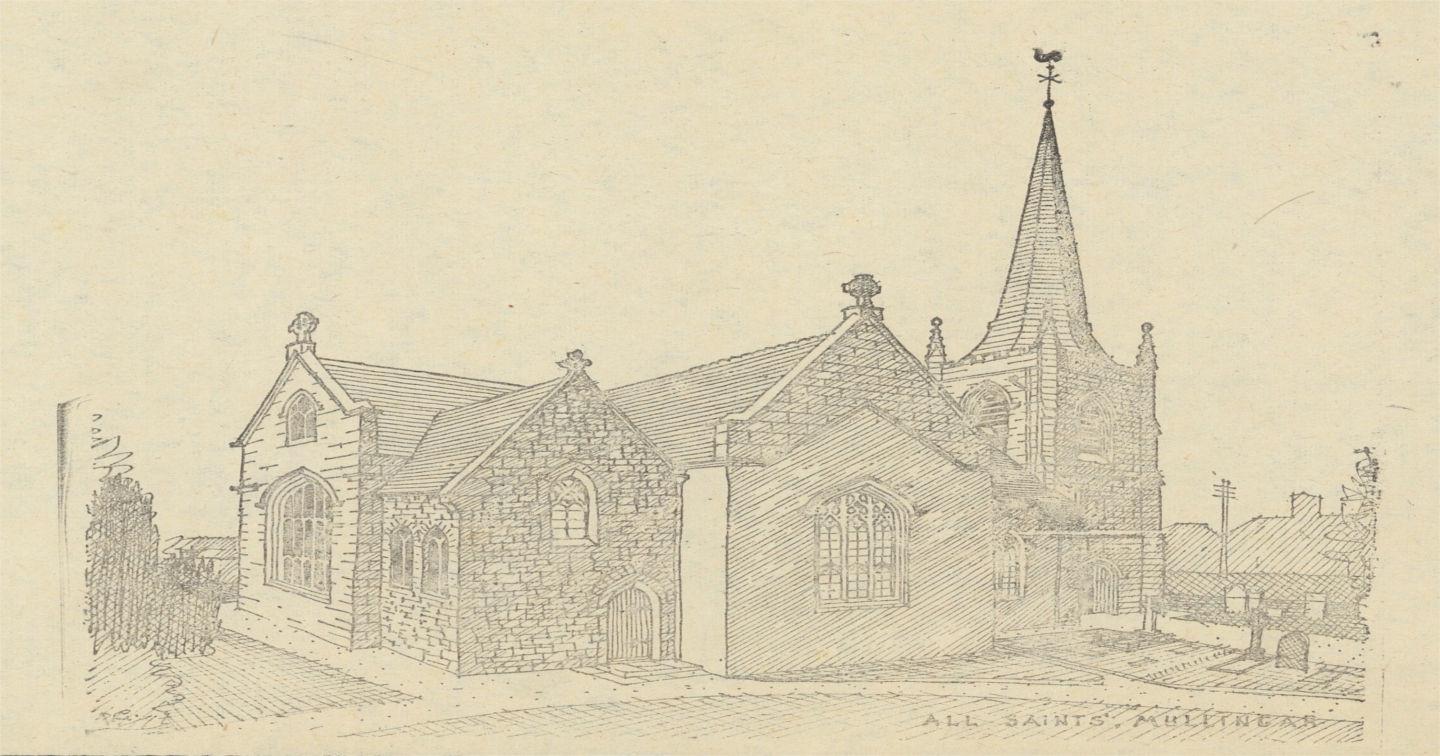
by Harry Haskins
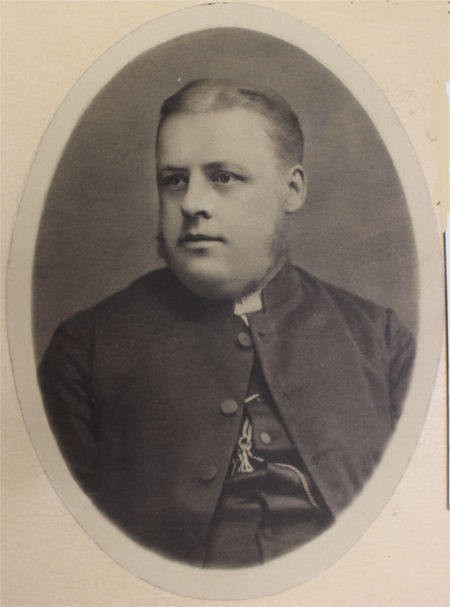
During a tidy–up of papers accumulated at home over 20 years, a forgotten copy of the list of items held in the RCB Library for Mullingar Union of Parishes came to light. On a previous visit to the Library, I had obtained a copy of the Library’s hand–list to the collection, now available here, for my records. The List (numbered P.336 in the Library’s extensive run of parish collections) covers Mullingar’s treasure of archives, and item 20 is described as a ‘Scrapbook of William Reynell relating to the history of the Parish of Mullingar, 13th – 19th cent.’ On returning again to the Library, I was able to inspect the original ‘Scrapbook’, which I found to be a hardback book running to some 300 pages. Now a collaboration between the Library and Mullingar Union, has enabled the volume to be expertly digitised by Informa, and presented online for the first time as the Library’s Archive of the Month.
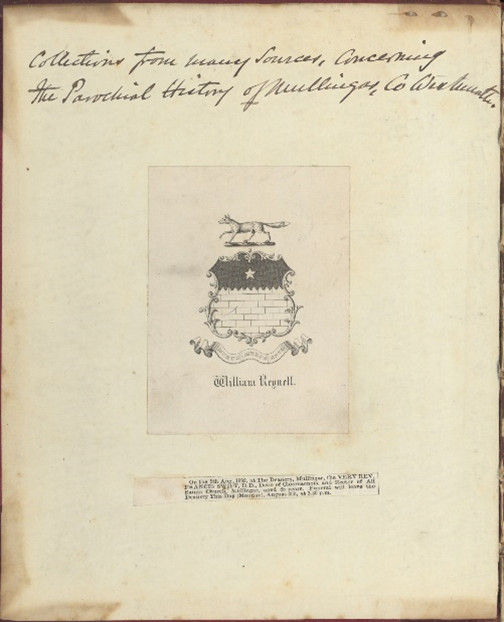
Several branches of the Reynell family lived in the Mullingar area for at least three generations before William Reynell was born in 1836. His great–grandfather Richard married Dorcas, daughter of Robert Cooke of Cookesborough, Co Westmeath, another well–known family in the Mullingar area. Further background about the parish’s history is available at this link. The Cooke family were parishioners of Killucan Parish, now part of Mullingar Union of Parishes, and further information about their most unusual mausoleum is available here.
The author of the Mullingar scrapbook was not only an ordained minister of the Church of Ireland, he was also a renowned antiquary and scholar who carried out extensive research on the succession of clergy of the Church with related historical investigations. Much of Reynell’s ministry was served in several different parishes in the dioceses of Derry and Kilmore, as his entry in the biographical succession lists of clergy records:
Reynell, William Alexander (1836 – 1906)
b. 1836 ed. TCD BA 1858, Div. Test. 1859, MA 1861, BD 1874; MRIA 1878, d. 1860 (Down for Derry); p. 1861 (Derry); C. Camus–juxta–Mourne (Derry) 1860–62; C. Donaghpatrick 1862–63; C. Kildallon (Kilmore) 1863–64; C. Tamlaghtard (do.) 1864–65; C. Leckpatrick (Derry) 1865–66; R. Carrick (do.) 1866–1873; I. St John’s, Cloverhill (Kilmore) 1873–77; C. St Michan’s, Dublin 1878–80; ret.
s. of Richard Winter, JP, High Sheriff Westmeath, and Alexandrina (nee Saunderson) of Killymon, Co Westmeath.
Died 3 March 1906.
Source: The Succession of the Derry Clergy since the Reformation (Ulster Journal of Antiquarians).
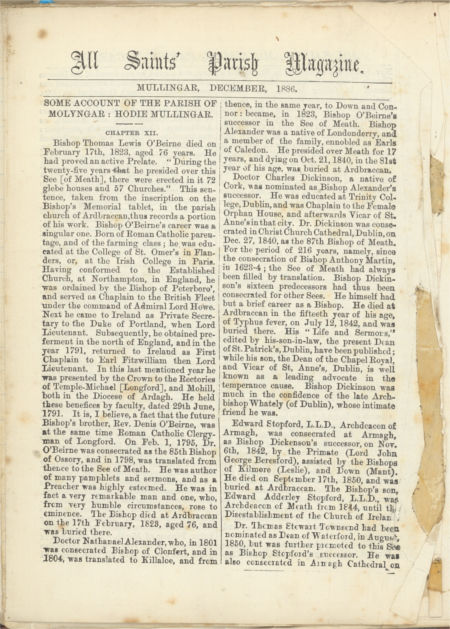
The RCB Library holds a number of items of correspondence of Reynell, and also various compilations by him, including an extensive collection of photographs and prints of bishops, clergy and laity of the Church – including his own photograph, as well as notebooks on various parochial and diocesan histories. For example, RCB Library MS 921 contains a miscellany of papers relating to the diocese of Derry, while MS 1082 is a notebook on sources for the parish histories of Carrick (Derry) and Newtown Kells (Meath).
By the time Reynell compiled the Mullingar scrapbook, he was retired and living at 8 Henrietta Street in Dublin, on the same street as the Registry of Deeds, which undoubtedly facilitated his research. The Mullingar scrapbook is more extensive than the other two, revealing a depth of research, which is explained by the fact that he published ‘The Parochial History of Mullingar’ in parts within various monthly editions of the All Saints’ Mullingar Parish Magazine during 1886 under the title ‘Some account of the Parish of Molyngar hodie Mullingar’. Helpfully, the scrapbook contains an almost full run of these publications which the Library has kindly completed here, the absent editions for August and September 1886 now available here as a standalone pdf on this link.
All Saints’ Church, Mullingar, was first referred to in a charter of 1192 – 1202, which noted that the church had been given to the Augustinian priory of Llanthony Prima in Wales by Simon of Rochford, Bishop of Meath. The link with Llanthony was retained until the Dissolution of the Monasteries in 1540 during the reign of Henry VIII.

The name Mullingar, or its historical spelling of Molyngar, has received various interpretations. Amongst them are the following:
1. The mill on the left side of the stream.
2. The dumb mill.
3. The red mill.
4. The short mill.
Today, the accepted translation is the left–handed mill.
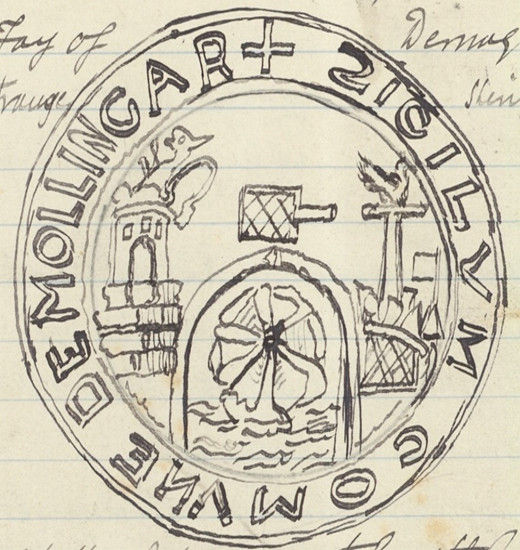
All of the foregoing interpretations refer to this mill, and the town seal bore as its chief device a ‘mill wheel’. This seal was lost, but turned up c.1880, when a peasant found it on his land. The seal passed through a number of hands, eventually ending up with an Alderman Day of Cork. The seal may be described as a circular bronze 2.25 inches in diameter. The central object in the seal is a waterwheel, beneath an archway, under which the water is flowing. Immediately above this is an implement resembling the square beetle, with a diapered pattern, which washerwomen use, but equally resembles a heckle for teasing or tearing flax or carding blankets. On the sinister (left) side of the arch is an embattled tower, out of which issues a demi–griffin rampant, while on the dexter (right) side is what may be called a church spire, with a bird resting on its cross, and beneath is a tented field with pennants flying. Around is the legend ‘Sigillum commune de Mollingar’. We have upon the ‘Sigil’ the symbol of the town in the waterwheel and heckle, which probably were typical of the staple trade of the place in the 16th or 17th centuries, from which the seal dates. The flange–like handle upon the back of the seal is partly perfect, in other respects it has been well preserved. The seal is now on display in the Medieval Section of the National Museum of Ireland, Kildare Street, Dublin.
In addition to the parish church (dedicated as All Saints’) there were three monastic establishments in the town of Mullingar. The oldest was the Augustinian Priory of St Mary, commonly known as ‘The House of God of Mullingar’, founded in 1227 by Ralph le Petyt, Bishop of Meath. This priory was richly endowed, one portion of its privileges was that the prior received from every house within the liberties of Mullingar, and out of every brewing, one measure of ale, commonly called ‘The Mary gallon’.
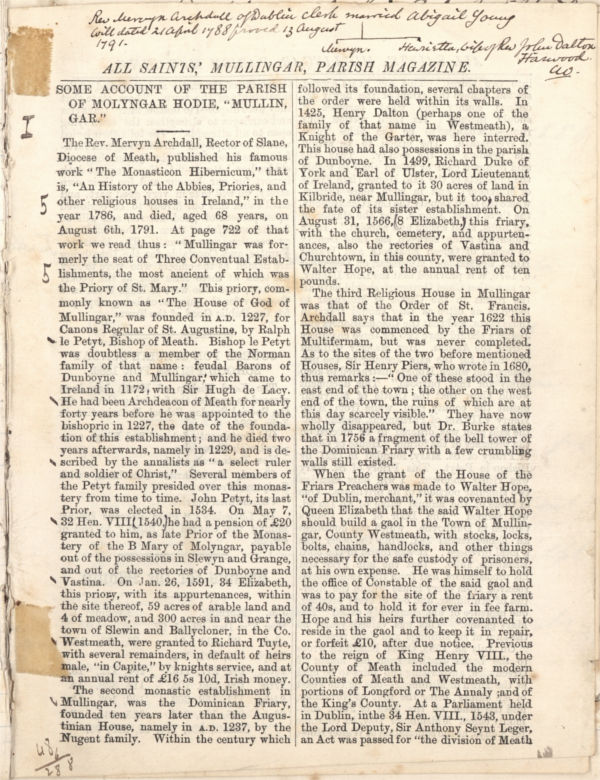
The second monastic establishment in Mullingar was the Dominican Friary founded 10 years later than the Augustinian House in 1237, by the Nugent family. Within the century which followed its foundation, several chapters of the order were held within its walls.
The third religious house in Mullingar was that of the Order of St Francis. This house was commenced by the Friars of Multifermam, but was never completed. As to the sites of the other two houses, Sir Henry Piers wrote in 1680: ‘One of these stood in the east end of the town; the other on the west end of town, the ruins of which are at this day scarcely visible’.
We learn something of the state of the diocese of Meath in the mid–16th century from a letter written by the then Rt Revd Hugh Brady to the Secretary of State. Hugh Brady was appointed as bishop of Meath on 21 October 1563, and on 14 March the following year he wrote to Sir William Cecil, the secretary of state:
Right Honourable, I now by experience find that a Bishopric is a greater burden than any honour. If I should respect quietness of life and contentment of mind I had rather be a Stipendiary Priest in England than Bishop of Meath in Ireland. O, what a sea of troubles have I entered into!
“…Storms rising on every side. The ungodly Lawyers are not only sworn enemies to the truth, but also; for lack of due execution of law, the overthrowers of the country. The ragged clergy are stubborn and ignorantly blind, so as there is little hope of their amendment; the simple multitude is through continual ignorance hardly to be won. So I find on all sides difficulty”
Bishop Brady seems to have gone to his work courageously and with some success. A regal visitation was held in 1615, about 30 years after his death and records that:
The number of preachers in this Diocese is thirty five. The number of reading ministers is forty. There is a public school kept in this Diocese at Trim by Thomas Whiteby, Minister and Preacher at Trim, and appointed by the Bishop of Meath to teach the public school there.
On 23 October 1641 the great Irish Rebellion commenced. The siege of Athlone soon followed, and in the immediate neighbourhood of Mullingar, on 7 February 1642, the famous battle between the Irish under General Thomas Preston, and the British under Sir Richard Greville, eventuating in the utter defeat of the former, was fought at the Pass of Rathconnell. At the outbreak of disturbances, William Sibthorp, parish clerk of Mullingar was hanged by the Irish, and Edmond Dalton and Mr Moorehead’s son were murdered, but there is no other mention of Mullingar during the stormy period which then ensued of civil war in Great Britain and Ireland.

We learn from an extract from the London Magazine included in the scrapbook that ‘on 29th July 1747 the town of Mullingar in the county Westmeath was in a great measure consumed by an accidental fire’. In spite of this disaster, later evidence of improvement of the town c.1800 is provided:
Mullingar is improving much, and considerably enlarging since the Royal Canal reached it. It is situated in a fine fertile country which abounds with woods and water and thickly inhabited. Being the shire town of County Westmeath it has an excellent Courthouse, a large building which makes a good appearance in the principle street…
“…There is also a market house, a good stone building, and the County Jail. The houses in the main street are mostly 3 storey high and slated. As to their places of worship, the Roman Catholic chapel has the advantage, being a large new building, making a very decent appearance and accommodating a very large and respectable congregation. However I would recommend to the Protestant inhabitants of that town and neighbourhood to erect a better building for the service of their God, than the old church, which seems occasionally vamped up with a kind of niggardly parsimoniousness unworthy of the chief town of the County Westmeath. There is generally a Regiment of Foot besides Cavalry quartered in Mullingar; at present their accommodation is very tolerable, but a new barracks is to be immediately built, which will still further add to the beauty of this thriving town.”
A meeting of All Saints’ vestry presided over by the Revd Francis Lambert, then vicar of Mullingar, was held in October 1813. It was resolved that the parish church should be rebuilt and a spire added to the tower. These works were carried out in 1814 during the incumbency of the Revd Robinson, and the church took on the form as seen today. In 1856 the Revd John Hopkins was appointed vicar of All Saints’, during his tenure the present vestry room and the chancel aisle, or chapel, appropriated to the Lyons’ family, were added to the fabric. The Revd Charles Parsons Reichel DD succeeded Hopkins as vicar of All Saints’ in July 1864. During his tenure the great bell, which now hangs in the tower, was purchased by subscription. The bell was cast by the firm of J. Murphy of Dublin, and cost £300. It was described in 1870 as being ‘one of the largest bells of its type in Ireland, it is 15 feet in circumference and 5 feet tall … [and] weighed two and a half tons’. When the bell arrived at the church, the doorway of the tower had to be enlarged to get the bell into the church. The bell pealed for the first time in October 1870; it rang out in C sharp tenor.

The Revd Dr Reichel left Mullingar in 1875, and in 1885 he was elected bishop of Meath. He was one of only two rectors the parish to become the bishop of the diocese of Meath, the other being Ralph le Petit in the 13th century. Dr Reichel was consecrated in St Patrick’s Cathedral, Dublin, on Tuesday 29 September 1885, being the Feast of Saint Michael and All Angels. The archbishop of Dublin acted on this occasion in place of the Lord Primate, who was unable to attend through old age and infirmity. Also present were the bishops of Down and Connor, Kilmore, Elphin and Ardagh, and Killaloe and Clonfert.
The Report of the Ecclesiastical Commissioners, Ireland, ordered to be printed by the House of Commons in 1837, contains the following account of Mullingar church which gives us a vivid picture of what it was like in the 19th century. We may take it that building commenced in 1813, as the source below shows, but we know it re–opened for worship the following year:
One Church capable of accommodating 400 persons, re–built and enlarged in 1813 at a cost of £3,553 16s 11d. Divine Service is performed twice on Sundays, and on Good Friday and Christmas Day, besides Morning Service every Wednesday and Friday, and the Sacrament is administered fourteen times in the year
By 1868, according to the Report of the Established Church Commission, the number of members in the parish was 574.
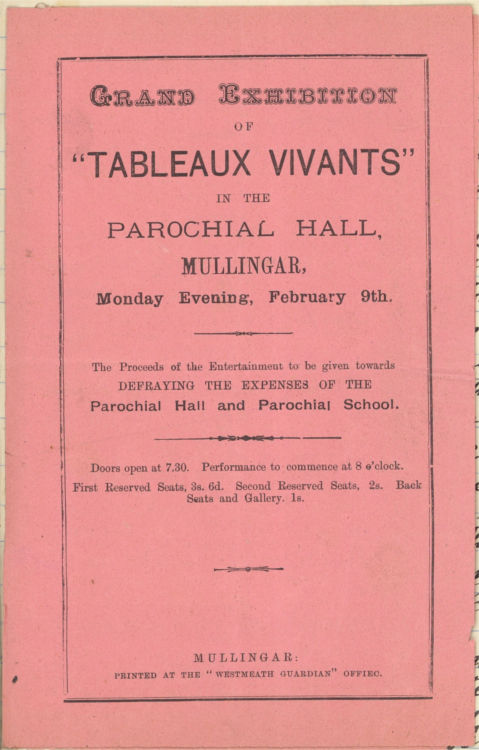
Reynell’s scrapbook contains a host of other useful documents and printed items not readily available elsewhere and thus a one–stop shop for local historians and parishioners alike. These include a rare copy of a publication printed in Mullingar, entitled ‘An Authentic Report of the Address of Baron Sir William Smith and Others … ‘ to ‘Those Acquitted at the Assizes at Mullingar, in 1831’. Later a copy of the service sheet for the re–opening of the Church of All Saints, following its renovation on 25 September 1878, together with an undated “Tableaux Vivant” programme of dramatic events, and the concert programme for music performed by local musicians to raise funds for the parish in 1901 provide snap–shots of times past.
The digitised version of Reynell’s scrapbook is available here
Further information about Mullingar Union is available at this link.
(If you would like to contribute to the RCB Library Conservation Fund, please click here.)
Dr Susan Hood
Librarian and Archivist
RCB Library
Braemor Park
Churchtown
Dublin 14
D14 N735
01 492 3979
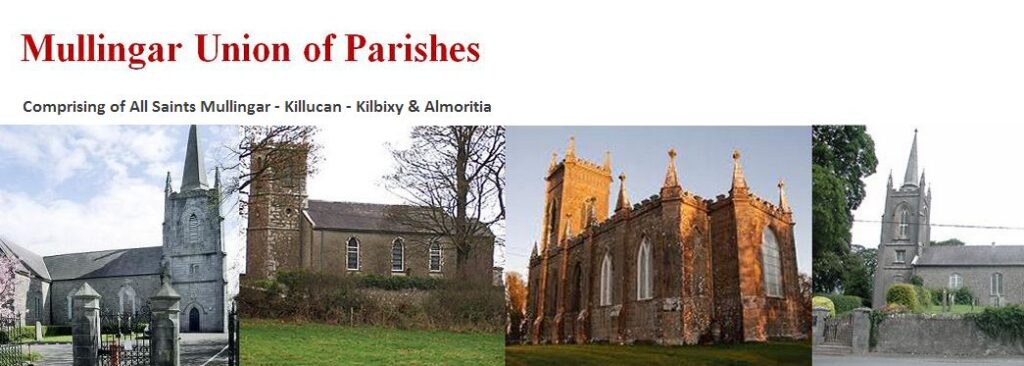


Leave a Reply